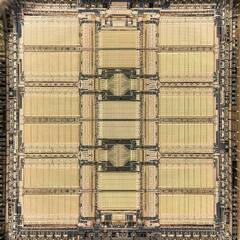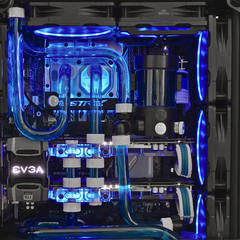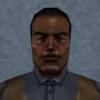
Shanhara
Member-
Posts
75 -
Joined
-
Last visited
Awards
This user doesn't have any awards
Profile Information
-
Gender
Male
-
Location
The Observatory
System
-
CPU
intel core i7-7820x
-
Motherboard
Asus ROG rampage vi extreme
-
RAM
Gskill trident Z RGB 32GB
-
Case
Thermaltake view 71tg RGB
-
Storage
samsung 960 evo 500gb , 2 x seagate firecuda 3.5" 2tb
-
PSU
Corsari HX1200i
-
Keyboard
ROG flare
-
Mouse
Logitech G900 Chaos spectrum
Recent Profile Visitors
530 profile views
Shanhara's Achievements
-
I'm not sure what you mean. My boot drive (gen3 M.2) and two other HDDs show up in the BIOS. The new drive does not show up.
-
It doesn't show up here. I've been checking in the BIOS directly just to be sure.
-
Yeah, the DIMM.2 slot is enabled by default and seems like it still is. In fact, I couldn't find any options to disable it either, other than for VROC. I know that 28 lane CPUs can only use a certain side of the DIMM.2 module and while it was on the wrong side initially, I corrected this as well. I tried using it in both PCH and CPU Storage modes and neither worked, if that's what you're talking about
-
Maybe try to see if there's a response with a different PSU? If there's no response anywhere in the PC my guess would be that it has to do something with the PSU. Also this might be obvious and you might have checked but maybe make sure the outlet in the wall is working properly?
-
The motherboard I'm using a Rampage VI Extreme and I have an i7-7820x. I just bought a Crucial PCIE 4.0 m.2 drive. I already have an old Samsung 960 as my boot drive so I figured I'd finally use the DIMM.2 on my motherboard for the additional storage. However, my PC just does not detect the new drive. Everything else is working fine and the LED on the DIMM.2 module is also on but the drive just does not show up. My theory was that it might have to do with the PCIE lanes since the CPU only has 28 and I have a 3090 (PCIE 4) and a gen3 M.2 drive and adding the new gen4 drive might mean running out of lanes. However this does not add up as I have previously used a 3090 and and 1080 with the same PC at the same time, meaning it should still work, albeit slower. The only other thing that I can think is that the new drive is the problem. I could check by putting it in the primary M.2 slot but that would be a real pain so I wanted to see if there's anything else it could be. Any help would be much appreciated.
-
My Sata Cables and hard drives keep breaking... sort of
Shanhara replied to Shanhara's topic in Troubleshooting
I would but I can't help but feel like the drives themselves aren't the problem because when I took them to the Data Recovery place, they were working the second they plugged them in. I'm wondering if the problem could be with the MoBo or the PSU perhaps... -
Recently I had a problem where both my hard drives (not the boot drive, Seagate Firecuda) would not get detected in BIOS at all. I changed the cables and everything was fine then. But once again randomly after turning my PC off completely (plugging it out of the wall) and turning it on, my hard drives would not get detected. I changed cables again to no avail. I took the drives to a data recovery place and somehow one of them was working and I also managed to get the data out of the one that was not working because both were being detected by the BIOS for some reason. The problem I'm having is that every time I turn my PC off completely, it seems like the Hard drives/SATA cables randomly stop working or start working. The cables are new and from Asus, they came with my motherboard and aren't physically damaged in any way as far as I can tell. I'm just trying to figure out what the main problem is here. Edit: When I say SATA cables I mean the ones that go between the MoBo and the drives, not the power cable
-
ok I did some minor "testing" if you could call it that, basically I booted up in Q mode, and used GPU Z to check the BIOS version, and then changed the GPU to Q mode to do the same, and sure enough, there were different BIOS versions. The only worry I have is that I don't want to mess up and brick Q mode as well
-
A new BIOS came out recently for my strix 3080, the one with the resizable BAR support. I downloaded the BIOS updater from the ASUS drivers and BIOS page and I installed it. I then did a driver update and shut down my PC. now the GPU doesn't even get detected. In P mode at least, because everything works just fine in Q mode (there's a physical switch on GPU to switch between them). Is there any way to resolve this?
-
What watercooler should i get for under $120?
Shanhara replied to BaconWarrior270's topic in Custom Loop and Exotic Cooling
The Thermaltake Riiing coolers are not static and ROG RYU is nto static -
What watercooler should i get for under $120?
Shanhara replied to BaconWarrior270's topic in Custom Loop and Exotic Cooling
There's corsair's H115i Pro RGB and the H150i Pro RGB. There's also ASUS's RYOU. The ASUS and H150i Pro RGB are around 170 bucks but they're worth it. Especially the H150i Pro RGB which I use with my overclocked skylake-x processor. It is nearly perfect and I run my 7820x at 4.85 Ghz with it and only get around 73 degrees. -
How much would you suggest for the 7820x? I'm refraining a little from higher voltages because i'm not sure if my motherboard (Rampage Extreme) is loadline calibrated and might throw in higher voltages.
- 5 replies
-
- skylake
- overclocking
-
(and 3 more)
Tagged with:
-
I'm doing 1.180 on all cores with 1.200 for the performance cores I run AIDA64 for a while and then ASUS RealBench. If it passes both, i run timespy, firestrike, and unigine heaven. After all of that, just to be sure if it does fine in actual applications I encode a random 20 minute 4K clip I have in .H264 and then some GTA V and AC Odyssey
- 5 replies
-
- skylake
- overclocking
-
(and 3 more)
Tagged with:




